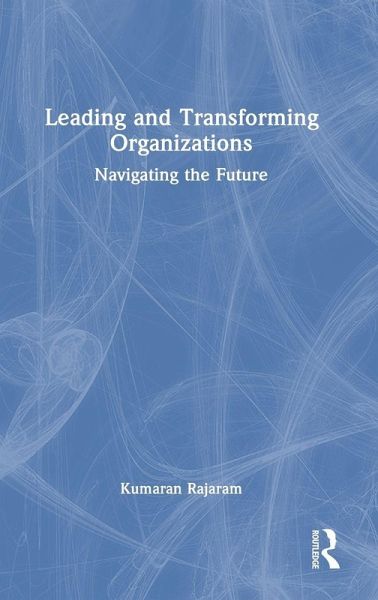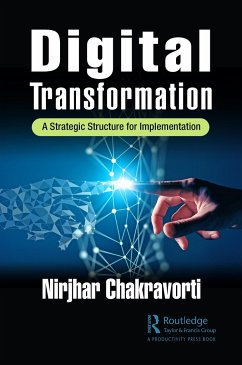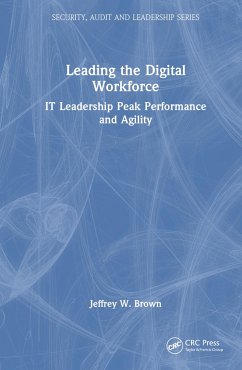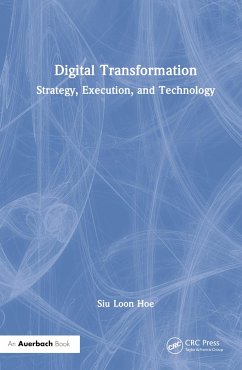Versandkostenfrei!
Versandfertig in 1-2 Wochen
Weitere Ausgaben:

PAYBACK Punkte
76 °P sammeln!





This book outlines the roadmap to organizational success and explains how companies can adapt and optimise their business performance through strategic positioning, business sustainability and crisis management. It will be an essential guide for leaders, practitioners and anyone who is formulating effective organizational strategies.
Kumaran Rajaram, PhD, is Senior Lecturer with the Leadership, Management, and Organization Division at Nanyang Business School, Nanyang Technological University, Singapore.
Produktdetails
- Verlag: Routledge
- Seitenzahl: 212
- Erscheinungstermin: 27. Februar 2023
- Englisch
- Abmessung: 240mm x 161mm x 16mm
- Gewicht: 487g
- ISBN-13: 9781032260501
- ISBN-10: 1032260505
- Artikelnr.: 66269413
Herstellerkennzeichnung
Libri GmbH
Europaallee 1
36244 Bad Hersfeld
gpsr@libri.de
Dr. Kumaran Rajaram provides excellent insights on effective leadership from his experiences in large organizations, in academia, as an entrepreneur, and consultant. This book gives leaders tools and skillsets to resolve various dilemmas. The dilemma of dealing with current pressing needs and strategizing for the future; dilemma of being agile yet developing a strong culture; dilemma of being competitive/bottom-line driven yet managing with strong ethical foundations. While other management/leadership books exist, Dr. Rajaram's book astutely shows how his insights can be applied in the context of fast technological advancement, digitalization, and new work arrangements such as remote work.
FOO Maw-Der, PhD (MIT)
FOO Maw-Der, PhD (MIT)
Mehr anzeigen
Professor, Nanyang Business School, Nanyang Technological University, Singapore Director, Nanyang Technopreneurship Center Director, Asian Business Case Center
This book astutely examines and discusses strategic issues concerning leaders in contemporary volatile times. The concepts and examples provided are relatable to both scholars and practitioners, thus offering both theoretical and practical insights. It is a highly recommended read for instructors and researchers who are keen to adopt sustainable and agile leadership strategies to navigate dynamic business environments!
Chong SinHui, PhD Assistant Professor, Division of Leadership, Management and Organization, Nanyang Business School, Nanyang Technological University, Singapore
Current executives and business leaders are experiencing greater change, pressure, uncertainty, and complexity than ever before. And, it seems likely that the presence of these factors will only increase. This may be the biggest threat to organizations and the biggest challenge for organizational leaders. To prepare future leaders to navigate this environment successfully, different approaches to developing leaders and leading are necessary. Leading and Transforming Organizations: Navigating the Future is a unique scholarly/practice-oriented book that informs both current leaders and next-generation leaders on the cutting-edge ideas that are necessary for navigating the tumultuous now as well as the increasingly tumultuous future.
Ryan Gottfredson, PhD Associate Professor, College of Business and Economics, California State University, Fullerton, United States
Dr Rajaram's book discusses cutting-edge topics and latest skills with which leaders, strategists, and managers need to be well-versed and equipped to face twenty-first century challenges, including developing transformative leadership skills in a remote VUCA work environment, meeting ethical and sustainable business standards, and adapting to and striving in digital ecosystems. I recommend Dr Rajaram's book to any leader, strategist, and manager involved in leading and transforming an organization for the twenty-first century.
Ludvig Levasseur PhD, Assistant Professor in Entrepreneurship, Indian Institute of Management Bangalore and Junior Research Fellow, Institute for Development Strategies, O'Neill School of Public and Environmental Affairs, Indiana University
This book is a timely reminder of the importance of leadership in the organizational context. The world is going through rapid changes due to nationalism, the pandemic, climate change, war, and economic upheaval. Organizations must adapt to such socio-political changes. This book raises important factors that can help organizations succeed in such changing circumstances. Leaders play a vital role in this process. The book provides novel leadership strategies in re-evaluating organizational strategies and commitments that can incorporate the changing nature of employees and work, management, and governance in the face of crises and change.
Sarbari Bordia, PhD Professor, Deputy Director Research, Research School of Management, Australian National University
Dr. Kumaran is spot on in identifying the three pillars for transformative change - leadership (self and team), innovative culture and dynamic strategizing for value proposition. The topics are timely for a post pandemic era where the corporates are trying to find the fine balance between the internal challenges around the future of work and the external ones driven by disruption, high-competitive intensity, shorter life cycles, shifting customer preferences and macro-economic factors. Innovation is oxygen for companies - and Dr. Kumaran lays down both the big picture and a detailed playbook that make corporate transformation a reality.
Manish Sinha, PhD, CFA Director & Head of Venture Building, Nanyang Technological University - NTUitive Pte Ltd
Dr. Rajaram's book is a very resourceful one for professionals in any industry that try to cope with and navigate the turbulent and complex landscape in the digital era. It is also a perfect resource for researchers and teaching faculty to understand some of the key challenges and concepts that the business leaders deal with today. Delivering a mix of deep-dive theories and real-world applications, the book provides a set of evidence-based and practice-oriented frameworks as well as recommendations. I highly recommend this book to anyone trying to gather knowledge in this subject.
Mr. Paul Li, Head, Strategic Partnerships, Nanyang Executive Education, Nanyang Business School, Nanyang Technological University
Dr. Kumaran's book on Leading and Transforming Organizations: Navigating the Future Creating and Managing Change comes at the right time of unprecedented global change. As organizations scramble to adapt to the digital economy transformation, they must be agile. From a holistic perspective, strategic positioning is about how a company differentiates itself from its competitors and delivers value to its targeted markets. In my capacity as head of strategy at my organization, I recognize the significance of strategic positioning in advancing its development. While a strategic positioning approach enables an organization to devise the right mix of strategies that can help them gain an edge over their competition, the book's greatest value is that it teaches readers how to restrategize through re-value propositions, enabling organizations to be agile and responsive and promoting strategies that allow them to do so.
Dr. Samson Tan, Head, Strategic Development, Libraries & Education, Civica Pte Ltd, Singapore
This nine chapter book on Leadership and Transformation is an excellent book intended for researchers and practitioners, as well as teachers and students of Leadership and Strategy. It covers a wide gamut of topics and issues that are faced by business leaders: the future of work, innovation to address grand challenges, strategizing the value proposition, ethics and corporate governance, digitalization and technology management, change management, crisis management, sustainability and preparing for the future. The book can be used as a valuable reference by practitioners and researchers alike and as a reference resource at both undergraduate and graduate levels by students and instructors. The beauty of Dr. Rajaram's book is that it covers both long-term strategic issues such as leadership, innovation, change management, and preparing for the future, as well as operational issues such as crisis management, sustainability and agility.
Professor S. Viswanathan, Nanyang Business School, Nanyang Technological University, Singapore
This book is a mind-opener for an audience that cares about the vital issues leaders and strategy-makers of organizations are facing today. In particular, it elaborates on the need for transformation and adaptation in a business environment that has never been more 'VUCA' (volatile, uncertain, complex, and ambiguous) before. It contextualizes crucial leadership responsibilities against the backdrop of the COVID-19 pandemic; the digital transformation bringing about various opportunities and threats; and the changing world of work. I highly appreciate the hands-on approach combining a rich theoretical underpinning with illustrative examples and outcome orientation. Leadership scholars will find plentiful inspiration for research strengthening their expertise in innovative value creation and strategy re-design, which will also enable them to support their business constituencies even better. Organizational leaders will find encouragement and practical guidance to design strategic transformation and to strengthen their crisis management capabilities.
Prof. Dr. Volker Rundshagen, Management and Tourism Studies, University of Applied Sciences Stralsund, Germany
A thoughtful book that niftily guides organizational leaders through complex transformation journeys. Readers involved in enormous transformation efforts will find this book indispensable. The book helps navigate the complexity of change by making sense of the situations, examining personal readiness, heightening awareness of people engagement, and charting multiple workstreams to drive implementation. Relevant theories and models are explained and linked closely to real-world examples. The book synthesizes the complex and competing ideas about leading and transforming organizations into a succinct yet complete framework that leaders can apply immediately. Rich in illustrations and broad in scope - this is a must-have resource for students and practitioners.
Associate Professor (Practice) Phang Yew Keong, Nigel, Associate Dean (Executive Education), Nanyang Business School, Nanyang Technological University, Singapore
This is a unique book. Most books on leadership focus only on organizational issues and/or traits of a good leader as though the firm strategy is a separate factor. And most books on strategy treat the firm itself as key actor and downplays the charisma, the style, and the behavior of individual leaders within the firm. In contrast, this book addresses the intersection between leadership, strategy, and management. The book provides insights into how it is the firm leader (or the leadership team) who shapes the culture of the firm, directs the transformation process, and guides the firm in re-strategizing and re-positioning itself to achieve a competitive advantage in its chosen market. The leader or the leadership team is also the one that keeps the firm agile, well-governed, and constantly prepared to deal with current and future disruptions. Each chapter is infused with deep discussions of contemporary issues that enable strategy and management scholars to rethink the validity of existing theories. Each chapter also offers practical frameworks and in-depth case studies that enable practitioners to derive useful prescriptions for their actual leadership work. The book serves as an excellent guide to practicing enlightened leadership in today's volatile business environment and within organizations that are populated by a new breed of workers that hold a whole new set of values.
Lewis Lim, PhD, Associate Professor of Marketing (Practice), Academic Director, Nanyang Professional MBA Programme, Nanyang Business School, Nanyang Technological University, Singapore
Leading and Transforming Organizations offers evidence-based frameworks and recommendations for researchers in leadership, strategy, and management to advance their scholarly work. The insights and discussions in the book provide valuable perspectives on current trends and best practices in these areas. The book's practice-oriented approach makes it an ideal resource for MBA and E-MBA participants, C-suite leaders, executive coaches, and consultants. Its emphasis on evidence-based approaches makes it particularly useful for practitioners looking to apply research findings to real-world situations. The combination of theoretical and practical insights makes it an essential resource for faculty looking to incorporate the latest research and practices into their courses. The book's value proposition lies in its ability to provide a comprehensive overview of current thinking and best practices in leadership, strategy, and management. Researchers will find the book's in-depth analysis and recommendations invaluable in shaping their future research agendas. Practitioners and teaching faculty will benefit from the book's practical, evidence-based approach to problem-solving and decision-making.
Leesa Soulodre, MBA, MiM, General Partner, R3iVentures
This book astutely examines and discusses strategic issues concerning leaders in contemporary volatile times. The concepts and examples provided are relatable to both scholars and practitioners, thus offering both theoretical and practical insights. It is a highly recommended read for instructors and researchers who are keen to adopt sustainable and agile leadership strategies to navigate dynamic business environments!
Chong SinHui, PhD Assistant Professor, Division of Leadership, Management and Organization, Nanyang Business School, Nanyang Technological University, Singapore
Current executives and business leaders are experiencing greater change, pressure, uncertainty, and complexity than ever before. And, it seems likely that the presence of these factors will only increase. This may be the biggest threat to organizations and the biggest challenge for organizational leaders. To prepare future leaders to navigate this environment successfully, different approaches to developing leaders and leading are necessary. Leading and Transforming Organizations: Navigating the Future is a unique scholarly/practice-oriented book that informs both current leaders and next-generation leaders on the cutting-edge ideas that are necessary for navigating the tumultuous now as well as the increasingly tumultuous future.
Ryan Gottfredson, PhD Associate Professor, College of Business and Economics, California State University, Fullerton, United States
Dr Rajaram's book discusses cutting-edge topics and latest skills with which leaders, strategists, and managers need to be well-versed and equipped to face twenty-first century challenges, including developing transformative leadership skills in a remote VUCA work environment, meeting ethical and sustainable business standards, and adapting to and striving in digital ecosystems. I recommend Dr Rajaram's book to any leader, strategist, and manager involved in leading and transforming an organization for the twenty-first century.
Ludvig Levasseur PhD, Assistant Professor in Entrepreneurship, Indian Institute of Management Bangalore and Junior Research Fellow, Institute for Development Strategies, O'Neill School of Public and Environmental Affairs, Indiana University
This book is a timely reminder of the importance of leadership in the organizational context. The world is going through rapid changes due to nationalism, the pandemic, climate change, war, and economic upheaval. Organizations must adapt to such socio-political changes. This book raises important factors that can help organizations succeed in such changing circumstances. Leaders play a vital role in this process. The book provides novel leadership strategies in re-evaluating organizational strategies and commitments that can incorporate the changing nature of employees and work, management, and governance in the face of crises and change.
Sarbari Bordia, PhD Professor, Deputy Director Research, Research School of Management, Australian National University
Dr. Kumaran is spot on in identifying the three pillars for transformative change - leadership (self and team), innovative culture and dynamic strategizing for value proposition. The topics are timely for a post pandemic era where the corporates are trying to find the fine balance between the internal challenges around the future of work and the external ones driven by disruption, high-competitive intensity, shorter life cycles, shifting customer preferences and macro-economic factors. Innovation is oxygen for companies - and Dr. Kumaran lays down both the big picture and a detailed playbook that make corporate transformation a reality.
Manish Sinha, PhD, CFA Director & Head of Venture Building, Nanyang Technological University - NTUitive Pte Ltd
Dr. Rajaram's book is a very resourceful one for professionals in any industry that try to cope with and navigate the turbulent and complex landscape in the digital era. It is also a perfect resource for researchers and teaching faculty to understand some of the key challenges and concepts that the business leaders deal with today. Delivering a mix of deep-dive theories and real-world applications, the book provides a set of evidence-based and practice-oriented frameworks as well as recommendations. I highly recommend this book to anyone trying to gather knowledge in this subject.
Mr. Paul Li, Head, Strategic Partnerships, Nanyang Executive Education, Nanyang Business School, Nanyang Technological University
Dr. Kumaran's book on Leading and Transforming Organizations: Navigating the Future Creating and Managing Change comes at the right time of unprecedented global change. As organizations scramble to adapt to the digital economy transformation, they must be agile. From a holistic perspective, strategic positioning is about how a company differentiates itself from its competitors and delivers value to its targeted markets. In my capacity as head of strategy at my organization, I recognize the significance of strategic positioning in advancing its development. While a strategic positioning approach enables an organization to devise the right mix of strategies that can help them gain an edge over their competition, the book's greatest value is that it teaches readers how to restrategize through re-value propositions, enabling organizations to be agile and responsive and promoting strategies that allow them to do so.
Dr. Samson Tan, Head, Strategic Development, Libraries & Education, Civica Pte Ltd, Singapore
This nine chapter book on Leadership and Transformation is an excellent book intended for researchers and practitioners, as well as teachers and students of Leadership and Strategy. It covers a wide gamut of topics and issues that are faced by business leaders: the future of work, innovation to address grand challenges, strategizing the value proposition, ethics and corporate governance, digitalization and technology management, change management, crisis management, sustainability and preparing for the future. The book can be used as a valuable reference by practitioners and researchers alike and as a reference resource at both undergraduate and graduate levels by students and instructors. The beauty of Dr. Rajaram's book is that it covers both long-term strategic issues such as leadership, innovation, change management, and preparing for the future, as well as operational issues such as crisis management, sustainability and agility.
Professor S. Viswanathan, Nanyang Business School, Nanyang Technological University, Singapore
This book is a mind-opener for an audience that cares about the vital issues leaders and strategy-makers of organizations are facing today. In particular, it elaborates on the need for transformation and adaptation in a business environment that has never been more 'VUCA' (volatile, uncertain, complex, and ambiguous) before. It contextualizes crucial leadership responsibilities against the backdrop of the COVID-19 pandemic; the digital transformation bringing about various opportunities and threats; and the changing world of work. I highly appreciate the hands-on approach combining a rich theoretical underpinning with illustrative examples and outcome orientation. Leadership scholars will find plentiful inspiration for research strengthening their expertise in innovative value creation and strategy re-design, which will also enable them to support their business constituencies even better. Organizational leaders will find encouragement and practical guidance to design strategic transformation and to strengthen their crisis management capabilities.
Prof. Dr. Volker Rundshagen, Management and Tourism Studies, University of Applied Sciences Stralsund, Germany
A thoughtful book that niftily guides organizational leaders through complex transformation journeys. Readers involved in enormous transformation efforts will find this book indispensable. The book helps navigate the complexity of change by making sense of the situations, examining personal readiness, heightening awareness of people engagement, and charting multiple workstreams to drive implementation. Relevant theories and models are explained and linked closely to real-world examples. The book synthesizes the complex and competing ideas about leading and transforming organizations into a succinct yet complete framework that leaders can apply immediately. Rich in illustrations and broad in scope - this is a must-have resource for students and practitioners.
Associate Professor (Practice) Phang Yew Keong, Nigel, Associate Dean (Executive Education), Nanyang Business School, Nanyang Technological University, Singapore
This is a unique book. Most books on leadership focus only on organizational issues and/or traits of a good leader as though the firm strategy is a separate factor. And most books on strategy treat the firm itself as key actor and downplays the charisma, the style, and the behavior of individual leaders within the firm. In contrast, this book addresses the intersection between leadership, strategy, and management. The book provides insights into how it is the firm leader (or the leadership team) who shapes the culture of the firm, directs the transformation process, and guides the firm in re-strategizing and re-positioning itself to achieve a competitive advantage in its chosen market. The leader or the leadership team is also the one that keeps the firm agile, well-governed, and constantly prepared to deal with current and future disruptions. Each chapter is infused with deep discussions of contemporary issues that enable strategy and management scholars to rethink the validity of existing theories. Each chapter also offers practical frameworks and in-depth case studies that enable practitioners to derive useful prescriptions for their actual leadership work. The book serves as an excellent guide to practicing enlightened leadership in today's volatile business environment and within organizations that are populated by a new breed of workers that hold a whole new set of values.
Lewis Lim, PhD, Associate Professor of Marketing (Practice), Academic Director, Nanyang Professional MBA Programme, Nanyang Business School, Nanyang Technological University, Singapore
Leading and Transforming Organizations offers evidence-based frameworks and recommendations for researchers in leadership, strategy, and management to advance their scholarly work. The insights and discussions in the book provide valuable perspectives on current trends and best practices in these areas. The book's practice-oriented approach makes it an ideal resource for MBA and E-MBA participants, C-suite leaders, executive coaches, and consultants. Its emphasis on evidence-based approaches makes it particularly useful for practitioners looking to apply research findings to real-world situations. The combination of theoretical and practical insights makes it an essential resource for faculty looking to incorporate the latest research and practices into their courses. The book's value proposition lies in its ability to provide a comprehensive overview of current thinking and best practices in leadership, strategy, and management. Researchers will find the book's in-depth analysis and recommendations invaluable in shaping their future research agendas. Practitioners and teaching faculty will benefit from the book's practical, evidence-based approach to problem-solving and decision-making.
Leesa Soulodre, MBA, MiM, General Partner, R3iVentures
Schließen
Für dieses Produkt wurde noch keine Bewertung abgegeben. Wir würden uns sehr freuen, wenn du die erste Bewertung schreibst!
Eine Bewertung schreiben
Eine Bewertung schreiben
Andere Kunden interessierten sich für














